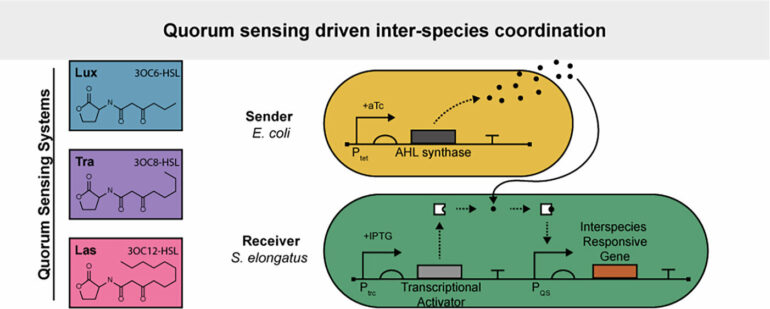Cyanobacteria, photosynthetic microorganisms which have widespread uses in the production of pigments, antioxidants and supplements and potential ones in biofuels and plastics, have a new way to communicate to control their population, researchers from the MSU-DOE Plant Research Laboratory, or PRL, Ducat lab show.
In nature, bacteria “talk” to each other using proteins and a small molecule. In this two-part system, one “talks” by making a small molecule that goes out into the environment and the other picks up that molecule and “listens.”
The researchers in the PRL Ducat lab engineered these mechanisms into cyanobacteria. This research is published in ACS Synthetic Biology.
“E. coli will talk and cyanobacteria will listen, basically trying to replicate the mechanisms in bacteria communications in nature,” said Manos Kokarakis, co-first author of the study and graduate student in the Ducat lab and the Department of Microbiology & Molecular Genetics.
In nature, these two species would not share a common language. This work shows that conversations between two species is possible and that multiple ways of talking and listening can change the outcome of the conversation.
Engineering them to communicate in this way will help the researchers grow cyanobacteria at larger scales.
“In order to recreate the robustness of natural communities [of cyanobacteria], we’re going to need some of the same strategies that they use,” said Danny Ducat, associate professor in the Department of Biochemistry & Molecular Biology. “This is one step toward that, with the ultimate goal of creating a strong and stable community that expands the potential for cyanobacterial bioproduction as opposed to just in the lab.”
Rees Rillema, co-first author of the study, added, “What’s really cool about this mechanism is the signal is completely passive and diffuses into the environment. It doesn’t require any active transports, so it’s super cheap for the cells to do.” Rillema is a graduate student in the Ducat lab, the Department of Biochemistry & Molecular Biology and the Molecular Plant Sciences graduate program.
Cyanobacteria research is a newer field of study, and as such, the toolkits for working with these microorganisms are limited. Engineering this communications system into cyanobacteria significantly expands the tools the researchers can use in working with these microorganisms.
Kokarakis continued, “The next step is to have self-inducible systems in cyanobacteria using this mechanism,” meaning the researchers won’t have to start the communication, but the cyanobacteria will do it on their own. “We will ideally be able to activate genes in cyanobacteria in mass density.”
“There’s the added benefit that [cyanobacteria] fix carbon dioxide,” Rillema added, meaning they take CO2 from the atmosphere, like plants do. “If you’re making a carbon-based substrate, all that carbon is getting sucked out of the atmosphere and fixed into a product that you’re then selling, so this is a nice carbon neutral, pushing toward carbon negative option.”
More information:
Emmanuel J. Kokarakis et al, Developing Cyanobacterial Quorum Sensing Toolkits: Toward Interspecies Coordination in Mixed Autotroph/Heterotroph Communities, ACS Synthetic Biology (2022). DOI: 10.1021/acssynbio.2c00527
Provided by
Michigan State University
Citation:
Engineering cyanobacteria for cross-cultural exchange (2023, April 14)



